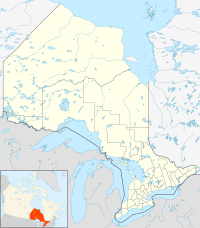Pikangikum First Nation facts for kids
Quick facts for kids
Pikangikum 14
Bigaanjigamiing
|
|
|---|---|
| Pikangikum Indian Reserve No. 14 | |
| Country | |
| Province | |
| District | Kenora |
| First Nation | Pikangikum |
| Area | |
| • Land | 8.59 km2 (3.32 sq mi) |
| Elevation | 335 m (1,099 ft) |
| Population | |
| • Total | 2,100 (2,011 census) 4,500 (2,019 reported) |
| • Density | 111.3/km2 (288/sq mi) |
| Time zone | UTC-6 (CST) |
| • Summer (DST) | UTC-5 (CDT) |
| Area code(s) | 807 |
The Pikangikum First Nation (/pɪˈkændʒɪkəm/, Ojibwe: Bigaanjigamiing) is an Ojibwe First Nation community. It is located on the Pikangikum 14 Reserve in Northwestern Ontario, Canada. The main part of the community is on Pikangikum Lake, which is part of the Berens River. This river flows into Hudson Bay. Pikangikum is about 100 kilometres (60 mi) north of Red Lake.
As of 2011, about 2,443 people were registered with the community. Most of them, around 2,334 people, live on the reserve itself.
Contents
History of Pikangikum
In 2005, a study found that people in Pikangikum still speak their original language a lot. This is more than many other First Nations in Northern Ontario. The language they speak is Ojibwe. It is a main dialect of the Anishinaabe peoples.
Pikangikum Clans
The community has different doodem, which are like family groups or clans. These clans are:
- Caribou (Adik)
- Sturgeon (Name)
- Pelican (Zhashagi)
- Skunk (Zhigaag)
Getting to Pikangikum
The main way to reach the community is by airplane. People fly into the Pikangikum Airport. There is also a water airport for planes that land on water.
During winter, special winter roads open up. These roads connect Pikangikum north to Poplar Hill First Nation. They also connect south to Red Lake and Ontario Highway 125.
Education in the Community
The community's only school burned down in 2007. After that, students learned in temporary buildings called portables. A new school, called Eenchokay Birchstick School, opened in 2016.
Pikangikum's Economy
Many people in Pikangikum rely on traditional ways of life. This includes hunting, fishing, and trapping. These activities are very important for the community.
In November 2020, Pikangikum was the first community in Canada to get access to Starlink internet. This new satellite internet service brought high-speed Internet access to the community for the first time.
Whitefeather Forest Initiative
Since 1996, Pikangikum First Nation has been working on the Whitefeather Forest Initiative. This project is about managing their land and resources. It also helps with community development. The Ojibwe name for this initiative is Waabimiigwan Noopimaakamig Maajitaawin.
Through this project, the First Nation works with the Government of Ontario. They manage the Whitefeather Forest, which is a large area of land. This land is part of Pikangikum's traditional territory. In 2006, the First Nation finished their land use plan called "Keeping the Land." The province approved this plan.
"Keeping the Land" helps guide how the land will be used in the future. This includes things like forestry, protected areas, and eco-cultural tourism. The plan is based on the traditional knowledge of the Pikangikum people. It has three main parts:
- Stewardship Strategy: This means respecting all living things.
- Customary Activities: These are the physical, mental, and spiritual activities needed to live well on the land.
- Economic Development: This involves new ways to make a living. These new ways fit with the traditional approach to taking care of the land. They help the Pikangikum people thrive today.
Fun and Recreation
Hockey is a very popular activity for young people in Pikangikum. They often play on the frozen Lake Pikangikum when it's cold enough.


